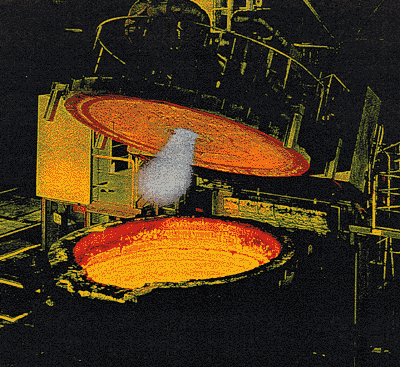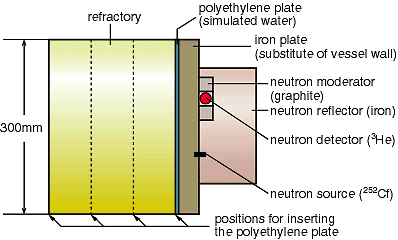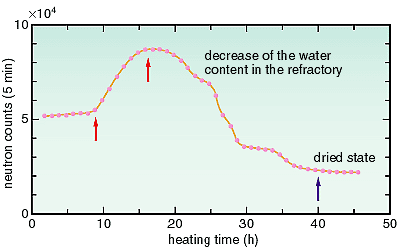Huge heat-resistant vessels are employed to transport molten iron
or steel in ironworks. Special refractory material, covering the inner
surface of a thick iron vessel-wall, should be renewed when damage reaches
a serious stage. In the process of renewal, a wet material mixture,
densely coated on the surface, is dried with a gas burner for a long
time (Fig. 4-13). Up until now, it was difficult to keep the drying
process at an optimum condition which is important for making a refractory
of high quality, due to the lack of a means to directly measure moisture
in the wet refractory.
A mobile moisture gauge with high sensitivity has been developed which
can measure even a very low content of moisture in the refractory. In
a model experiment (Fig. 4-14), basic characteristics of the moisture
gauge were examined in different conditions of source-detector distance,
neutron reflector, where a polyethylene plate containing plenty of hydrogen
was used instead of water in the vessel. The measurement sensitivity
of the developed gauge is about six times higher than that of a conventional
one, by the effective use of neutron multi-reflection and moderation.
Application experiments have been carried out at an actual spot of refractory
drying, the gauge being placed on the outer surface of a vessel for
carrying molten steel. The water in the wet refractory moves toward
the outer side as heat drying progresses, and is finally released as
steam through small holes in the iron wall. As shown in Fig. 4-15, the
change in neutron counts clearly indicates this phenomenon. Remarkably
different patterns of changes have been observed at different portions
of the vessel wall.
This new technique is expected to be useful also for the diagnosis and
improvement of many other drying processes of the refractory, etc. |


